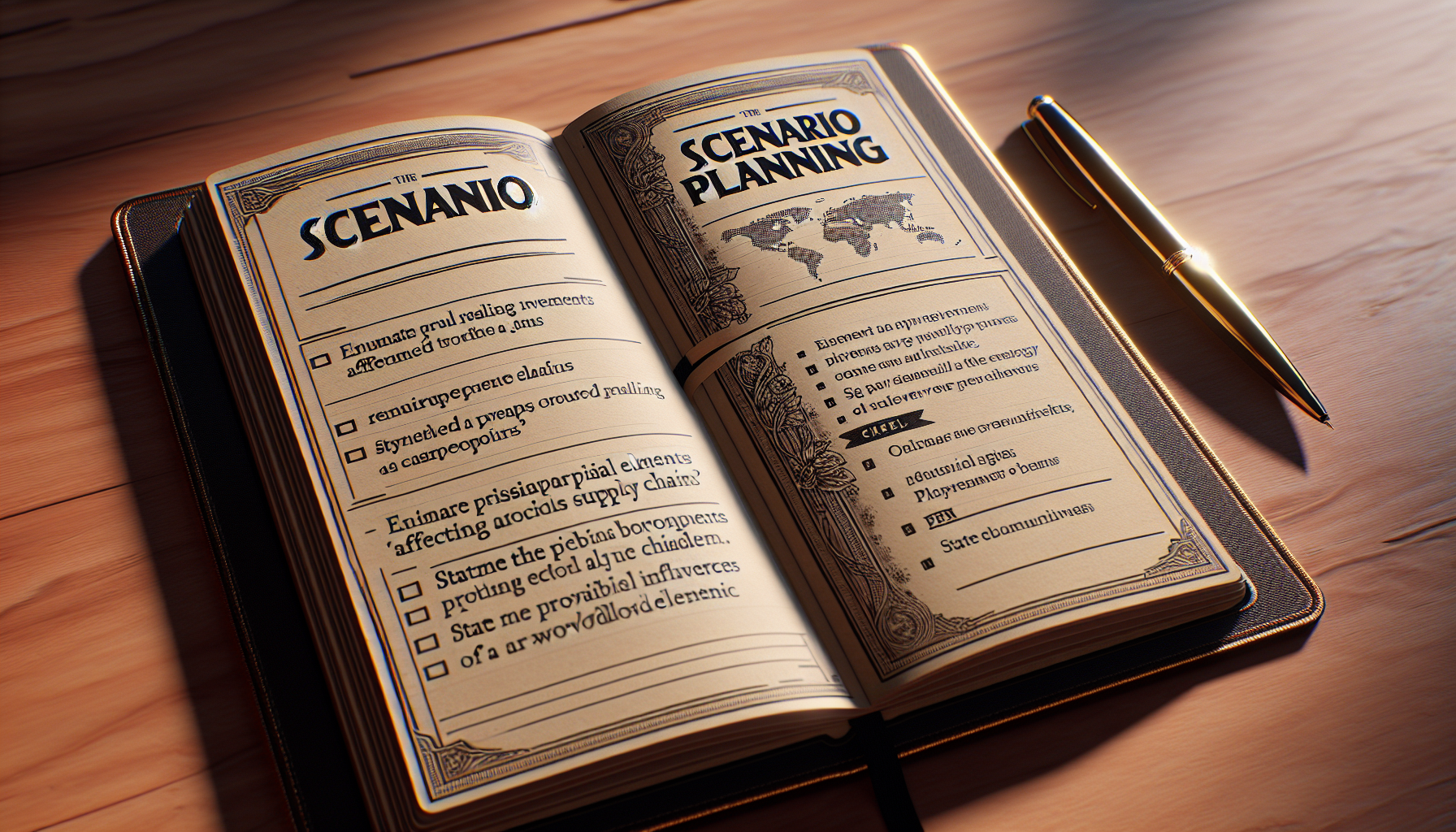If you’ve ever found yourself staring at a blank slate while trying to plan for the future, you’re not alone. Scenario planning can be a bit daunting, especially when it feels like you’re juggling a million “what ifs.” It’s normal to feel overwhelmed by the uncertainty, but you don’t have to tackle it alone.
What if I told you that there’s a way to make this process smoother and even a bit fun? By using ChatGPT, you can generate creative scenarios, brainstorm ideas, and gain fresh perspectives. Stick around, and I’ll show you how to take advantage of this powerful tool.
We’ll explore the ins and outs of scenario planning, suggest effective prompts, share tips for crafting your own, and help you avoid common pitfalls. By the end, you’ll be ready to tackle any future challenge with confidence!
Key Takeaways
- Scenario planning helps businesses prepare for future uncertainties by exploring multiple plausible outcomes.
- Using ChatGPT can simplify scenario creation and make it enjoyable by generating fresh perspectives and ideas.
- Effective prompts for ChatGPT include specific questions like potential market scenarios and strategies for overcoming challenges.
- Keep prompts clear and specific to avoid confusion and ensure relevant responses from ChatGPT.
- Avoid common mistakes such as overly complex prompts, lack of context, and neglecting a range of scenarios.

Best ChatGPT Prompts for Scenario Planning
Scenario planning is a powerful tool that helps organizations anticipate and prepare for future uncertainties.
Using ChatGPT, you can derive meaningful insights and generate varied scenarios to enhance your planning process.
Here are some effective prompts you can directly use with ChatGPT:
- “Outline three potential scenarios for the impact of economic downturns on my industry.”
- “Generate a future scenario where remote work becomes the norm for all sectors. What challenges might arise?”
- “Describe a positive outcome of climate change on agriculture in the next 20 years.”
- “List five worst-case scenarios for product launch failures and ways to mitigate each risk.”
- “Create a detailed scenario that includes both threats and opportunities for my business in 2025.”
Understanding Scenario Planning
Scenario planning is a strategic method used to make flexible long-term plans.
It involves creating various detailed and plausible future scenarios based on different assumptions about how current trends might unfold.
By considering multiple potential futures, organizations can improve their strategic thinking and preparedness.
It’s crucial for businesses as it helps in identifying risks and opportunities, allowing leaders to be proactive rather than reactive.
Scenario planning can be approached through different techniques, including workshops, simulations, and iterative discussions.
The main types of scenario planning include norm-based, explorative, and predictive scenarios, each serving different strategic needs.
How to Use ChatGPT for Scenario Planning
To effectively use ChatGPT for scenario planning, start by defining what specific scenarios you want to explore.
Consider leveraging AI as a brainstorming partner to bring diverse perspectives into the scenario creation process.
Here’s a simple step-by-step guide:
- Identify the key variables that affect your situation (e.g., market trends, technological developments).
- Formulate clear prompts that ask ChatGPT for plausible future outcomes based on these variables.
- Review the generated scenarios critically, and use them as a foundation for further discussions.
- Integrate the insights gained into your strategic planning and decision-making processes.
This not only enriches your understanding but also fosters dynamic planning methods.
Examples of Effective Scenario Planning Prompts
If you’re looking for practical examples, here are some realistic scenario planning prompts to try:
- “What are three scenarios for how our market could evolve over the next five years?”
- “Describe a situation where our competitors outperform us. What strategies could we adopt to counter this?”
- “Generate potential responses for our company in the event of a major supply chain disruption.”
- “List potential regulatory changes impacting our industry and how we might prepare for them.”
- “Visualize the possible economic impacts of a major technological breakthrough in our field.”
These prompts will help you engage ChatGPT in meaningful discussions that can clarify your planning efforts.

Tips for Crafting Your Own Scenario Planning Prompts
Creating effective prompts for ChatGPT requires a mix of clarity, specificity, and creativity.
Your prompts should clearly convey what you’re looking for to get the best results.
Broaden your thinking by considering the audience and purpose behind your prompts.
Here are some actionable tips to help you craft compelling scenario planning prompts:
- **Be Specific**: Instead of vague requests, ask targeted questions. For example, use “Identify three major factors that could disrupt our supply chain in the next year.”
- **Use Open-Ended Questions**: Encourage expansive responses by phrasing prompts like, “What scenarios could play out if we expand our market to Asia?”
- **Tailor to Your Needs**: Adjust the complexity of your prompts based on your specific context. For instance, a tech startup might ask, “What are potential future trends in AI that could impact our services?”
- **Incorporate Key Variables**: Integrate critical elements into your prompts. For example, “Assess the potential implications of regulatory changes in the energy sector for our business strategy.”
- **Iterate and Improve**: Don’t hesitate to refine your prompts based on the outcomes. You might say, “What three strategies can we employ if a recession hits next fiscal year?” and tweak as necessary.
Common Mistakes to Avoid in Scenario Planning with ChatGPT
While using ChatGPT can greatly enhance your scenario planning, there are some common pitfalls to avoid.
Being aware of these missteps can help ensure you’re making the most of this powerful tool.
Here are the key mistakes to steer clear of:
- **Overly Complex Prompts**: If your commands are too intricate, it may confuse the AI or lead to poor results. Keep it straightforward, like “List potential technological disruptions in the next five years.”
- **Ignoring Context**: Lack of context can result in irrelevant scenarios. Make sure your prompts include information, such as “Provide scenarios in the context of a retail business facing economic challenges.”
- **Inadequate Scenario Details**: Vague prompts yield vague answers. Instead of “Tell me about the future,” try “Describe how a global pandemic might affect urban transportation planning.”
- **Assuming AI Will Replace Critical Thinking**: Remember, ChatGPT should be a tool to complement your analysis, not replace it. Follow up with your insights and reasoning after using the AI’s output.
- **Neglecting a Diverse Range of Scenarios**: Focusing only on positive or negative outcomes can skew your perspective. Use prompts such as “What are both risks and opportunities in our market over the next decade?” to balance your scenario assessment.

Benefits of Using ChatGPT for Scenario Planning
Using ChatGPT for scenario planning brings several tangible benefits that can streamline your strategic efforts.
First, it enhances creativity by providing diverse perspectives and novel ideas that you might not consider on your own.
You can quickly brainstorm multiple scenarios, which saves time and allows you to focus on analysis and implementation.
ChatGPT offers data-driven insights that can help you understand trends better and make informed decisions.
This tool can significantly improve your decision-making process by allowing you to evaluate various potential outcomes side by side.
Moreover, leveraging AI for scenario planning gives you access to expert-level analysis without the need for extensive research.
To harness its potential, try these prompts:
- “Evaluate the impact of increasing telecommuting on urban development trends.”
- “What are the potential outcomes of a market entry strategy in a highly regulated industry?”
- “Analyze the effects of climate change on supply chain resilience and suggest key adaptations.”
Real-World Applications of Scenario Planning Prompts
Scenario planning prompts have practical applications across various fields, from business strategy to environmental assessments.
In the corporate world, companies use scenario planning to navigate market fluctuations and anticipate competitor moves.
For example, tech firms might explore scenarios of rapid innovation vs. stalled growth to shape their investment strategies.
In government, scenario planning aids policy makers in understanding social dynamics, such as urbanization and public health trends.
Healthcare organizations can model potential responses to pandemics, providing critical insights for resource allocation.
Consider using these prompts:
- “What potential public health scenarios should our city prepare for in the next ten years?”
- “Discuss how an environmental crisis could reshape our industry’s regulations and best practices.”
- “Identify three drastic shifts in consumer behavior in the wake of significant technological advancements.”
Conclusion on Using ChatGPT for Scenario Planning
In conclusion, integrating ChatGPT into your scenario planning can elevate your strategic capabilities.
The benefits of enhanced creativity, time savings, and access to expert-level analysis are vital in today’s rapidly changing environment.
As AI continues to evolve, its role in scenario planning is likely to grow, providing even more advanced insights.
Now is the time to embrace the innovation that AI offers, allowing you to stay ahead of the curve.
So, start incorporating these prompts into your planning sessions and watch your strategic thinking flourish.
Don’t wait—try out these ideas and see how they can transform your approach to scenario planning!
FAQs
Scenario planning is a strategic method to visualize and analyze potential future events. It helps organizations prepare for uncertainties, enabling proactive decision-making and nurturing adaptability in dynamic environments.
ChatGPT can generate diverse scenarios, prompt critical thinking, and provide insights into alternative outcomes. Its ability to process large datasets aids in uncovering patterns and trends relevant to strategic planning.
Common mistakes include failing to consider a wide range of scenarios, neglecting to update scenarios regularly, and not incorporating insights from diverse stakeholder perspectives, which can hinder effective planning.
Benefits include enhanced creativity in scenario generation, quick insights from extensive data, reduced workload for strategists, and the ability to simulate multiple outcomes, adding depth to planning processes.
